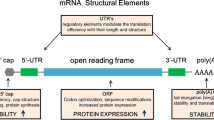Summary
GMK-monolayers infected with rubella virus developed a strong inhibiting effect on the multiplication of poliovirus but did not yield interferon in detectable amounts. The adsorption and the eclipse of the superinfecting poliovirus was not altered, but an extensive poliovirus RNA-synthesis was prevented. A well known early event of poliovirus infection, the inhibition of host cell protein synthesis, however, occurred in rubella virus infected cells as well as in normal cells.
Similar content being viewed by others
References
Parkman, P. D., E. L. Buescher, andM. S. Artenstein: Recovery of rubella virus from army recruits. Proc. Soc. exp. Biol. (N.Y.)111, 225–230 (1962).
Parkman, P. D.: Biological characteristics of rubella virus. Arch. ges. Virusforsch.16, 401–411 (1965).
Weller, T. H., andF. A. Neva: Biological characteristics of rubella virus as assayed in a human amnion culture system. Arch. ges. Virusforsch.16, 393–400 (1965).
Huygelen, C., J. Petermans, andA. Prinzie: An attenuated rubella virus vaccine (Cendehill 51 strain) grown in primary rabbit kidney cells. Progr. med. Virol.11, 107–125 (1969).
De Somer, P., A. Billiau, E. de Clercq, andE. Schonne: Rubella virus interference and interferon production. Antonie van Leeuwenhoek33, 237–245 (1967).
Fogel, A., andSt. A. Plotkin: Markers of rubella virus strains in RK13 cells cultures. J. Virol.3, 157–163 (1969).
Neva, F. A., andT. H. Weller: Rubella interferon and factors influencing the indirect neutralization test for rubella antibody. J. Immunol.93, 466–473 (1964).
Maasaab, H. F., andJ. A. Veronelli: Characteristics of serially propagated monkey kidney cell cultures with persistent rubella infection. J. Bact.91, 436–441 (1966).
Parkman, P. D., H. M. Meyer, R. L. Kirschstein, andH. E. Hopps: Attenuated rubella virus: I. Development and laboratory characterization. New Engl. J. Med.275, 569–580 (1966).
Wong, K. T., S. Baron, andT. G. Ward: Rubella virus: Role of interferon during infection of African green monkey kidney tissue cultures J. Immunol.99, 1140–1149 (1967).
Drinoveca, B., andO. Palacios: Interferenz des Rubellavirusin vitro. Zbl. Bakt. I. Abt. Orig.204, 48–55 (1966).
Desmyter, J., J. E. Melnick, andW. E. Rawls: Ineffectiveness of interferon production and of rubella virus interference in a line of Africain green monkey kidney cells (Vero). J. Virol.2, 955–961 (1968).
Desmyter, J., P. de Somer, W. E. Rawls, andJ. L. Melnick: The mechanism of rubella virus interference Int. Symp. Rubella vaccines. London 1968-Symp. Series: Immunbiol. Standard11, 139–148 (1969).
Darnell, J. E.: Early events in poliovirus infection. Cold Spr. Harb. Symp. quant. Biol.27, 149–158 (1962).
Holland, J. J., andJ. A. Peterson: Nucleic acid and protein synthesis during poliovirus infection of human cells. J. molec. Biol.8, 556–573 (1964).
Willems, M., andSh. Penman: The mechanism of host cell protein synthesis inhibition by poliovirus. Virology30, 355–367 (1966).
Yamazaki, Sh., andR. R. Wagner: Action of interferon: Kinetics and differential effects on viral functions. J. Virol.6, 421–429 (1970).
Levy, H. B.: Studies on the mechanism of interferon action. II. The effect of interferon on some early events in Mengo virus infected L-cells. Virology22, 575–579 (1964).
Thomssen, R., R. Laufs undJ. Müller: Physikalische Eigenschaften und Partikelgröße des Rubellavirus. Arch. ges. Virusforsch.23, 332–345 (1968).
Hsiung, G. D., andJ. L. Melnick: Effect of sodium bicarbonate concentration in plaque formation of virulent and attenuated polioviruses. J. Immunol.80, 282–293 (1958).
Thomssen, R.: Ein chromatographisches Verfahren zur Bestimmung typen-spezifischer Poliovirusantikörper mit32P-markiertem Poliovirus. Z. Naturforsch.18b, 798–808 (1963).
Scherrer, R., andJ. E. Darnell, Jr.: Sedimentation characteristics of rapidly labelled RNA from HeLa cells. Biochem. biophys. Res. Commun.7, 486–490 (1962).
Joklik, W. K., andJ. E. Darnell, Jr.: The adsorption and early fate of purified polioviruses in HeLa cells. Virology13, 439–447 (1961).
Lowry, O. H., N. J. Rosebrough, A. L. Farr, andR. J. Randall: Protein measurement with the Folin reagent. Biol. Chem.193, 450–455 (1951).
Long, W. F., andD. C. Burke: The effect of infection with fowl plaque virus on protein synthesis in chick embryo cells. J. gen. Virol.6, 1–14 (1970).
Ehrenfeld, E., andT. Hunt: Double stranded poliovirus RNA inhibits initiation of protein synthesis by reticulocyte lysates. Proc. nat. Acad. Sci. (Wash.)68, 1075–1078 (1971).
Author information
Authors and Affiliations
Additional information
The work described here was supported by a grant from the Deutsche Forschungsgemeinschaft.
Rights and permissions
About this article
Cite this article
Thomssen, R., Suhrkamp, E. & Bonk, S. Inability of rubella virus interference to reverse the inhibition of cellular protein synthetis caused by poliovirus. Archiv f Virusforschung 37, 62–70 (1972). https://doi.org/10.1007/BF01241151
Received:
Issue Date:
DOI: https://doi.org/10.1007/BF01241151




